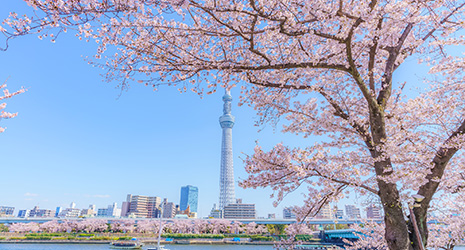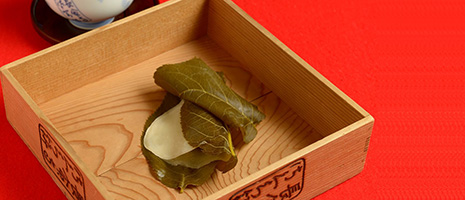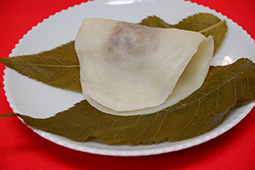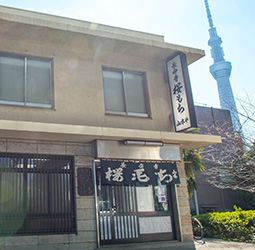INDEX
- English
- 日本語

Cherry blossoms on the banks of the Sumida River viewed from close to the shop - English
- 日本語

Chomeiji Sakuramochi

Chomeiji Sakuramochi 
Chomeiji Sakuramochi with Tokyo Skytree in the background
April 2021
Sakuramochi: A Spring Delicacy

Sakuramochi, a familiar sweet to the Japanese, is a confection that heralds the arrival of spring. One leading confectioner in Tokyo has been making sakuramochi for more than 300 years, when Tokyo was still called Edo.

Many Japanese crave sakuramochi when the cherry trees start to blossom in spring. There are two types of sakuramochi: the Kanto-style sakuramochi that originated in Tokyo, and the Kansai-style sakuramochi that originated in Osaka. They are both types of mochi (rice pounded into a paste and formed into a ball) wrapped in sakura cherry leaves that have been pickled in salt. The Kanto-style sakuramochi is typically flat while the Kansai-style is more rounded. Both have a pale rose or milky color. The sweetness of the bean paste with the subtle saltiness and the sweet aroma from the cherry leaves spreads in your mouth when you bite into the sakuramochi, allowing you to truly appreciate the arrival of spring.
Chomeiji Sakuramochi is a confectioner located near the Sumida River in Sumida City in eastern Tokyo, where the Kanto-style of sakuramochi originated. For more than 300 years, they have made only sakuramochi.
“We use carefully selected ingredients, and make sakuramochi by hand, dutifully following the original recipe,” says Yamamoto Yuko, the proprietress of Chomeiji Sakuramochi.

It all began in 1717, when Yamamoto Shinroku, the founder of Chomeiji Sakuramochi, began harvesting the leaves of the cherry trees that grow abundantly on the banks of the Sumida River, a place that was noted for its cherry blossoms even then, and pickling them with salt. The pickling process to ferment the leaves produces a fragrant substance called coumarin*, which has an aroma similar to vanilla. Yamamoto made the most of the aroma, adding a delicate flavor to the sweets, which he called “Chomeiji Sakuramochi” after the Chomeiji temple that once stood next to his original store.
“Chomeiji Sakuramochi” is characterized by two or three large leaves that are used to wrap the mochi. The leaves currently used are taken from Oshima cherry trees, a species of cherry tree grown in the western parts of the Izu Peninsula in Shizuoka Prefecture. They are said to produce a greater amount of coumarin. Interestingly, even Japanese people are often not certain whether they should eat the leaves with the mochi. Some eat them, and others do not.
“I recommend that people put the leaves aside and eat only the mochi inside,” Yamamoto says.

She explains that the mochi is already sufficiently infused with the flavor of the pickled cherry leaves. The leaves are also used to prevent the mochi from drying and to maintain its moist and soft texture.
The leaves adorn the mochi beautifully, and allow us to enjoy the wonderful aroma of the cherry blossoms that bloom in spring. Admire sakuramochi’s seasonal appearance and savor its aroma before you bite into it. They are two more attractive features of this traditional sweet.
* Coumarin is found in a number of plants including cinnamon. It is mildly toxic to humans when consumed in excess, which the Tokyo Metropolitan Institute of Public Health asserts is not the case in the standard Japanese diet.

